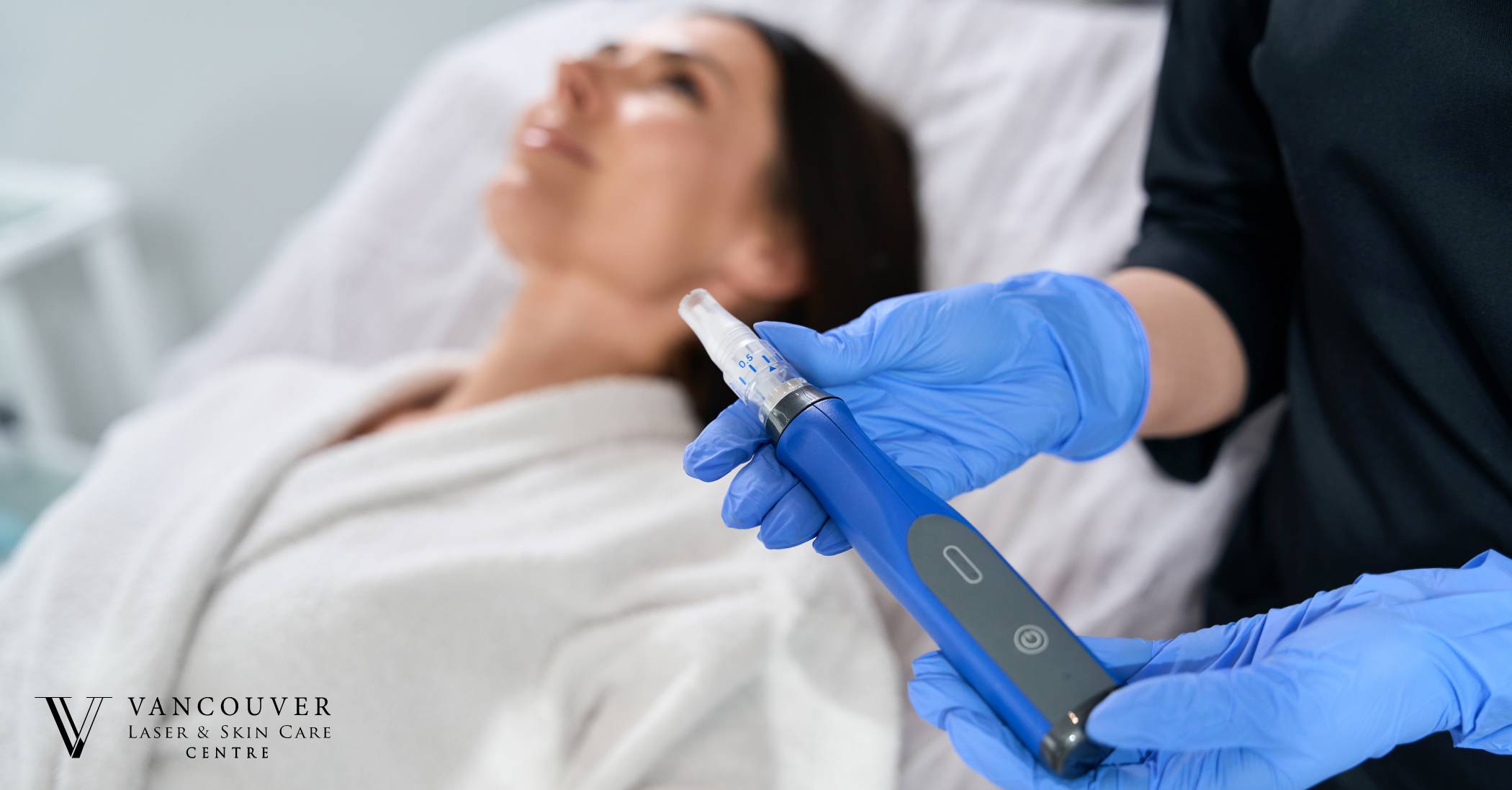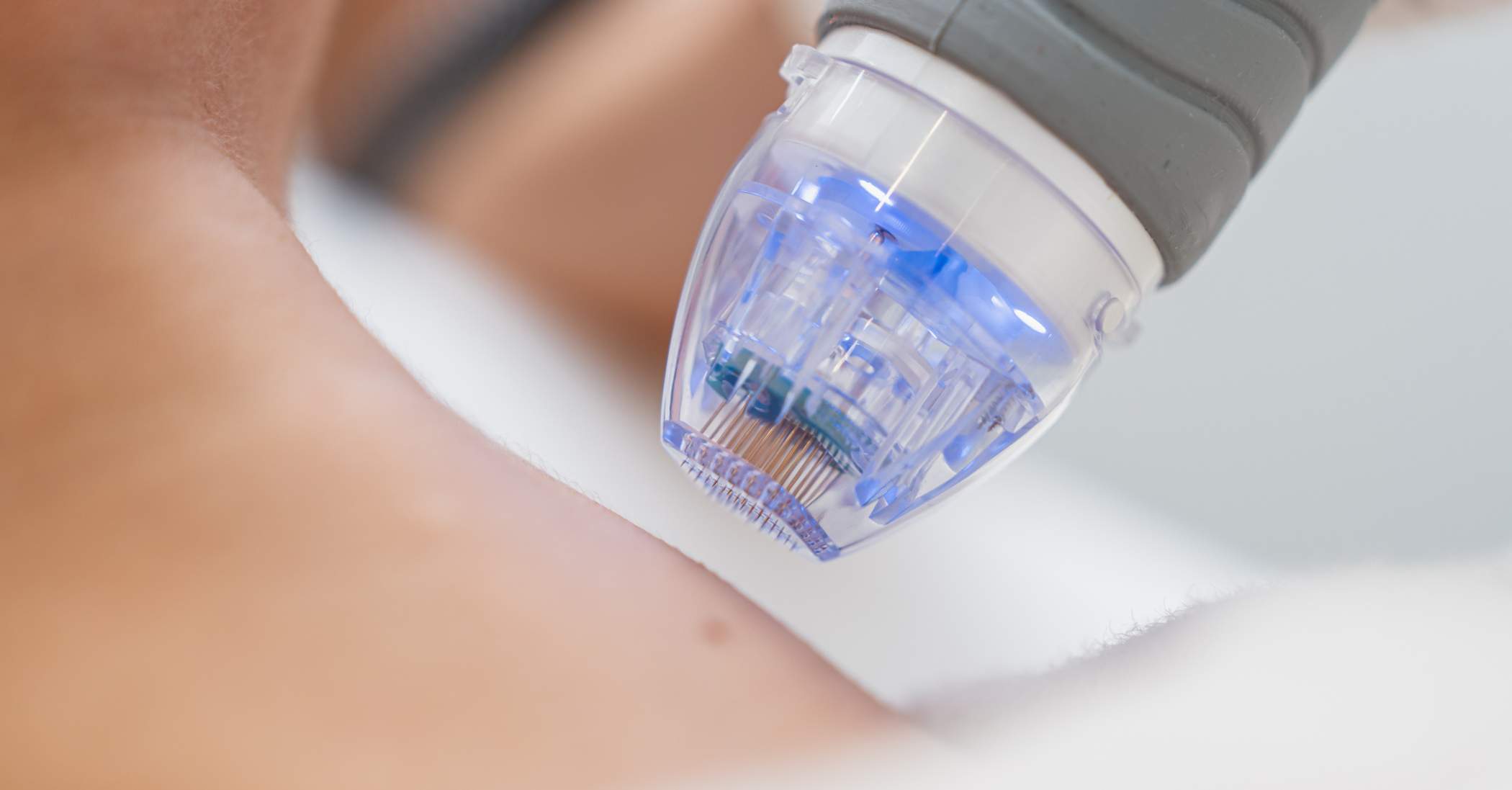Microneedling has become one of the most popular treatments in modern aesthetics. This minimally invasive procedure takes advantage of your skin’s natural healing process and encourages smoother, firmer, more youthful skin.
Microneedling initiates collagen production with the creation of tiny micro-injuries and is an effective solution for different skin concerns such as fine lines, wrinkles, acne scars, and uneven texture. Whether you’re looking for a subtle glow or deep rejuvenation, microneedling helps you meet radiant skin needs.
At Vancouver Laser, we specialize in treating microneedling patients with the best care and using advanced technology to ensure that the results will be maximized with as little downtime as possible.

How Does Microneedling Work Exactly?
Microneedling, also known as collagen induction therapy, skin needling, or percutaneous collagen induction, is a cosmetic treatment that involves puncturing the skin with small needles.
This process stimulates the body to send healing agents such as elastin and collagen to repair the skin. It aims to improve skin appearance by reducing fine lines, wrinkles, and enlarged pores.
If you get this treatment at a dermatologist’s office, they will likely numb your skin first to reduce pain. The idea behind this treatment is to use a derma roller, which inserts small, tiny stainless steel needles into your skin to cause minor injuries.
Usually, treatments last 10 to 20 minutes, although they may take longer if you experience any numbing.
Individual needs vary, so most people require more than one session. Fine lines and wrinkles may need two sessions a year, while burns or stretch marks may take as many as five sessions. Acne scars usually fall somewhere in between.
Many dermatologists also use additional treatments, such as depigmentation serums for hyperpigmentation or platelet-rich plasma, to help the skin heal better.
Types of Microneedling
There are different types of microneedling, and some are more effective than others. This, to some extent, can be confusing for patients because everyone has their own perception of what microneedling is.

Manual Microneedling
Manual microneedling is the most common type done at home using handheld devices such as derma rollers and stamps. These home devices are cheap, but they just can’t compete in effectiveness with office-based treatments.
That’s partly because the needles on these home devices are so short, severely limiting their ability to stimulate collagen production. Needles on at-home tools are usually less than 0.15 millimeters in length versus 0.5 to 2 millimeters for medical tools.
At-home devices improve exfoliation and allow other products, such as hyaluronic acid and vitamin C, to penetrate more effectively. The skin may appear brighter, but the rejuvenation effects are limited. If you do try this at home, apply even pressure while rolling the device in a multitude of directions across your face.
Clean the tool well to prevent infection by following specific cleaning directions. This usually entails washing it with soap and water and then soaking it in isopropyl alcohol.
Automated Microneedling
Automated microneedling uses a motorized pen-like device. This device can change its depth into the skin, depending on different areas of the face. The typical depth is about 2 to 3 millimeters to reach both the epidermis and dermis.
Radiofrequency Microneedling
During radiofrequency microneedling, the needles truly perforate the skin and simultaneously release high-intensity radiofrequency energy. This may stimulate new collagen formation with less injury to the outer skin layer. Radiofrequency microneedling is beneficial if performed well, but it must be personalized.
Microneedling Benefits
Microneedling is becoming popular because it offers many benefits. It helps refresh and plump the skin with little discomfort and downtime. The treatment can be customized for each person. Microneedling can improve:
- Scars, including acne scars
- Fine lines and wrinkles
- Enlarged pores
- Dark spots or hyperpigmentation
- Uneven skin tone
- Skin elasticity
- Stretch marks
- Hair growth in people with alopecia
Microneedling is usually cheaper than laser therapy and may work better for some individuals. Laser treatments use heat, which can change skin color. People with darker skin tones might prefer microneedling due to safety concerns with some laser treatments.

Microneedling Risks
Pain and Redness: After the procedure, you might feel minor discomfort, and your skin may be red for a few days.
Skin Peeling: Your skin may feel tight and flake as it heals.
Bruising and Bleeding: Microneedling usually doesn’t cause bleeding, but deeper treatments might lead to some bruising or bleeding.
Scarring Risks: Microneedling is not recommended for people with keloids, as it could worsen the condition.
Infection Risk: Microneedling creates tiny holes in the skin, allowing germs to enter if the equipment isn’t clean. However, the risk of infection is very low, especially if you are healthy.
Who Should Try Microneedling?
Microneedling has been applied to a wide range of cosmetic and medical uses. You may want to consider microneedling if you have any of the following:
- Large pores
- Fine lines or wrinkles
- Loose, thin, wrinkled skin
- Mild scars, especially those resulting from acne or burns
- Skin discoloration or uneven skin texture
- Stretch marks
Microneedling can be used for some medical conditions like the following:
- Alopecia areata (an autoimmune-related hair loss)
- Hyperhidrosis (excessive sweating)
Who Should Not Try Microneedling and Why?
Before getting microneedling, talk to your healthcare provider if you have:
- Acne or take acne medication.
- Blood disorders or use blood-thinning drugs.
- Cancer and are undergoing chemotherapy or radiation.
- Frequent skin rashes or cold sores.
- A tendency to develop keloids (hard, raised scars).
- Moles, freckles, skin tags, or other growths that change size, shape, or bleed.
- Skin conditions like eczema or psoriasis.

What is the Optimal Care for Skin After Microneedling?
After microneedling, avoid sun exposure, alpha-hydroxy acids and retinol skin care products, makeup, and sweating during the first week of recovery. Instead, stay hydrated, use antioxidant serum, use a cooling mask, and use collagen-stimulating peptides to help your skin heal.
Conclusion
Microneedling is an effective yet noninvasive skin texture smoothing treatment that also reduces scars and wrinkles and, in general, rejuvenates the skin. Tapping into the organic healing powers of your skin may have quite noticeable and long-lasting consequences with this kind of treatment.
At Vancouver Laser, our experienced team is dedicated to providing personalized care, using the latest technology to ensure safe and effective treatments. If you’re ready to refresh your skin and boost your confidence, book a consultation with us to explore how microneedling can work for you.
FAQs
1- How long do microneedling results last?
Microneedling results can vary depending on skin condition, treatment goals, and how well you follow post-treatment care. Typically, the initial skin texture and tone improvements can be seen within 2-4 weeks after the first session as collagen production ramps up. These results can last 3 to 5 months after a single treatment.
2- Is microneedling better than Botox?
Microneedling and Botox are different treatments for specific skin issues, so your choice depends on your goals.
Microneedling improves skin texture, reduces acne scars and fine lines, and rejuvenates the skin by boosting collagen production. It’s a natural, long-term way to enhance skin quality.
Botox relaxes facial muscles to smooth out dynamic wrinkles, such as crow’s feet, forehead, and frown lines. It works well for expression lines caused by muscle movement but does not improve skin texture or scars.
Choosing the right treatment depends on your needs. If you want smoother skin and to reduce scars, microneedling might be better. Botox could be more effective if you want to reduce expression lines and wrinkles. Many people choose to use both treatments to tackle various skin concerns.
3- How many sessions of microneedling do you need?
In order to see results, you should get at least 3–4 microneedling treatments that are spaced out every 4–6 weeks.



